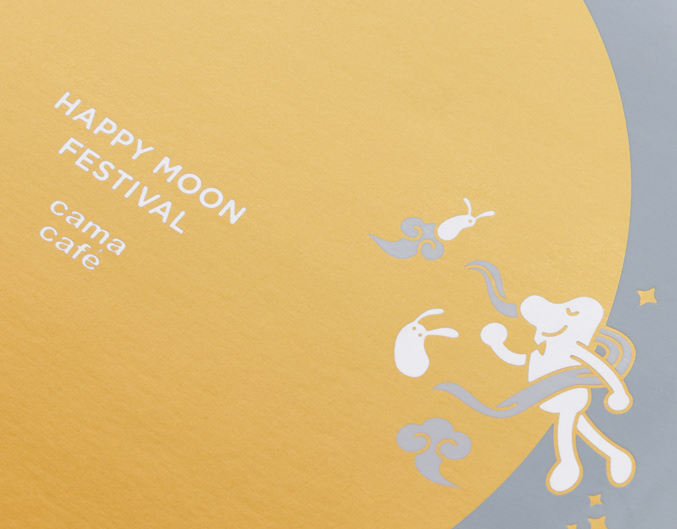Hold That Tiger by The Muddy Basin Ramblers
“Hold That Tiger” is the third full-length album by the jug band the Muddy Basin Ramblers, a group of US/UK expats living in Taipei, Taiwan. The album contains 22 tracks of mostly original music with styles ranging from swing jazz, blues, and ragtime to Taiwanese traditional temple parade music, Nakashi (known in Japan as Enka), Irish folk and even Taiwanese hip hop.
The song lyrics cover an eclectic mix of topics and themes, which include the phenomenon of folk religion and cults, the East/West cultural divide, the Asian immigrant diaspora in America, the Beat Generation, sci-fi/UFO kitch from the 1950s, and the history of jazz music.
To convey these topics, as well as the playful humor of the band, we created a visual theme that combines Taiwan's religious folk culture and Taoist mysticism, as well as a touch of 1950’s retro-futurism from the West.
The Cover
For the cover, the band suggested several songs to inspire the album's visual presentation: "Tiger Rag" is a jazz standard from the early 20th century, while "Beer Drinking Woman and a UFO," is a jug band-style blues song satirizing a Taiwanese UFO cult from the 1990s.
Many of the album's songs have lyrics and musical themes that contain references to Taiwanese and Chinese culture. So we borrowed from traditional Chinese folk art, invoking an iconic image of the Taoist figure Zhang Daoling, aka "Chinese Celestial Master Zhang Tianshi" (張天師神符), who is often portrayed with a tiger. The image is sourced from a Taoist paper talisman ("Fu"/符). The Fu talisman is traditionally kept to ward off evil or unwanted spirits and ghosts. To reflect how the album fuses the traditional with the modern, we "retro-fitted" Master Zhang with a space helmet, 3D glasses and a jug (often used as a homemade "tuba" by jug bands).
Liner Notes
The lyrics and liner notes are printed in both English and Chinese, with the latter accompanied by symbols representing Taoist magical spells, which were originally found on Fu talismans. These symbols were sourced from esoteric texts akin to a Chinese "grimoire," (a book of magic spells) which date back thousands of years. The grid layout for the lyrics was inspired by the standard chart form used in Purple Star Astrology (Zi Wei Dou Shu / 紫微斗數), a common form of Chinese fortune-telling with Taoist roots that dates back to the Tang Dynasty (during the years 618-907).
CD Sleeve
The CD is wrapped in a sheet of yellow paper that takes on the appearance of a Taoist Fu talisman. The printed calligraphy may look like abstracted Chinese glyphs, but is actually comprised of Roman letters, with the band's name written on the right ("The Muddy Basin Ramblers") and the title of the CD on the left ("Hold That Tiger"). This reconstruction technique is borrowed from artist Xu Bing's "square word calligraphy," in which he devised a system for writing English in a form that resembled Chinese characters. When folded using a origami hexagon folding technique, the CD sleeve emulates the appearance of a traditional Taiwanese amulet.
CD Surface Label
This design is derived from a Chinese zodiac wheel (denoting 12 palaces), which was printed in an antique fortune-telling chart originating from Yilan, Taiwan.
泥灘地浪人-擒虎記
台式復古未來主義
22 首英文新曲,收錄泥灘地浪人1900-1950 Jug Band、爵士、藍調、搖擺樂等一貫曲風,深掘台灣與美國各式民間軼事題材:台灣宮廟文化 (20. 宮廟藍調)、那卡西音樂 (19. 島嶼情歌第1號)、亞洲移民史 (6. 沒在怕海)、1950-1960 Sci-Fi 科幻電影 (17. 電台放送)、垮掉的一代 Beat Generation (3. 禪宗散拍)、爵士樂史 (8. 蚊子咆吼)、宗教狂熱 (18. 喝啤酒的女人與一架幽浮)......。
22 首英文新曲,收錄泥灘地浪人1900-1950 Jug Band、爵士、藍調、搖擺樂等一貫曲風,深掘台灣與美國各式民間軼事題材:台灣宮廟文化 (20. 宮廟藍調)、那卡西音樂 (19. 島嶼情歌第1號)、亞洲移民史 (6. 沒在怕海)、1950-1960 Sci-Fi 科幻電影 (17. 電台放送)、垮掉的一代 Beat Generation (3. 禪宗散拍)、爵士樂史 (8. 蚊子咆吼)、宗教狂熱 (18. 喝啤酒的女人與一架幽浮)......。
源於樂團對音樂的實驗,始於多元內容的極端迥異性格,試以宮廟文化為基,1950-1960復古未來主義 Retro-Futurism 為輔,深入文資搜集閱讀,並探究圖像、中英字體、編排、色彩等要件,重新揉合完成再想像,為我們深入骨子卻又不解的日常宮廟美學,暗自鑲嵌了現代、偷渡了未來,終至視覺創造完成。如浪人們為此次樂曲接上了地氣,視覺則化為一幅尋覓良久的獵奇靈籤。
擒虎記,源自一首古老的爵士經典《Tiger Rag 老虎散拍》,相傳由美國紐奧良非裔爵士樂手於1905所創,1918卻被白人組成的爵士樂團,錄音發行並剽竊了版權所有。藉樂史事件切題發揮,視覺也悄悄地「剽竊」了民俗信仰中的文化元素,專輯中的所有物件,彷彿廟宇中發予信眾的勸世刊物,仔細窺探卻發現事實並非如此單純。
抓住那隻老虎!闖入擒虎記的世界
取材東西方流傳於民間常民的古籍木刻版畫,鄉土、市井樸質而帶有粗糙感,將不相干的元件抽離自原有語境,解構拼貼並以繪畫與編排技巧縫合,先翻新而後又再復舊,設計在東西美學觀點象限中心交會,密密鋪陳了專輯中的每一吋篇幅,未存在一絲絲現代主義思維下的留白。
封套
騎虎仙人原型自張天師神符版畫再重繪,相傳張天師法力高強可驅雷役電,因降伏老虎而以虎為坐騎。亮黃封套外圍斜邊框取型自籤詩,仙人著閃電道袍,頭戴太空頭盔與紅藍3D眼鏡,手持 Jug Band 的靈魂「壺罐」,一掃莊嚴肅穆神明形象,反帶著獵奇衝突趣味。兩側法器替換為幽浮與電塔,巧妙融合元素,展演十足的「台式復古未來主義」。中文標題以執事牌扁平字搭配 19 世紀美國風格木刻字 (Wood Type),漢字威嚴霸氣與木刻字厚重粗獷組合,意外地協調。
歌詞
仿俗艷螢光的粉紅廉價命相紙、採東方算命術「紫微斗數十二宮格命盤」編排、依農民曆無間隔標點符號的中文排版;七位浪人身著古裝漢服、頭戴紳士帽、手持西方樂器與,化為衝突逸趣的奇異天官;英文排版藉文排版藉 19 世紀美國 Wood Type 組合台灣虎版畫,成就奇異詼諧的大型靈符;圖文穿插真實符咒 (道家祝由符籙) 對應歌曲主題:伏虎符 (擒虎記)、雷令符 (5. 電報)、化虎符 (2. 老虎散拍)、乘雲符 (18. 喝啤酒的女人與一架幽浮)、寶船 (6. 沒在怕海) 、瘧疾符 (8. 蚊子咆吼)......。
光碟符紙
光碟符紙
依據藝術家徐冰「新英文書法」,將英文 Typography 加上漢字構成右側樂團名 (The Muddy Basin Ramblers) 與左側專輯名 (Hold That Tiger),再造似字非字、似圖非圖的畫符美感,放大版的平安符由8道步驟摺為六角平安符並包裹光碟。
光碟圓標
將用以計算命運的紫微斗數十二宮格圓盤,嵌入樂團與專輯文樣。
擒虎記專輯,在音樂、主題、精神、形式與結構的巧妙契合之下,得以重新詮釋經驗中熟悉又陌生的「台灣宮廟民俗美學」,設計在過程環節中尋幽入微,於重重限制下將視覺推向極致。在會心一笑或心神領會中,散佚的記憶將被喚回,並發現一切竟出奇地珍貴而且美好。
____
Nominated for 62nd Grammy Award 2020 Best Recording Package
入圍 62 屆葛萊美 2020「最佳唱片設計包裝獎」
Winner of the 2019 Golden Melody Award Best Album Design
2019 金曲獎最佳裝幀設計獎
Buy Physical CD at BandCamp Other Albums: Formosa Medicine Show, Jug Band Millonaire EP: The Dance Age
入圍 62 屆葛萊美 2020「最佳唱片設計包裝獎」
Winner of the 2019 Golden Melody Award Best Album Design
2019 金曲獎最佳裝幀設計獎
Buy Physical CD at BandCamp Other Albums: Formosa Medicine Show, Jug Band Millonaire EP: The Dance Age










